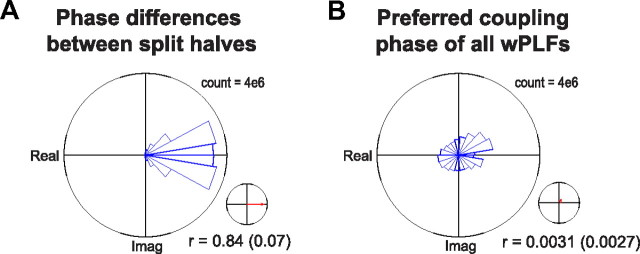Figure 4.
Diversity in preferred coupling phase is produced by reliable phase estimates. To estimate the reliability of our phase estimates, we randomly partitioned the trials of each dataset into two sets. A 4-way array of wPLFs was then calculated for each of the two sets of trials. A, Histogram of phase differences between wPLFs of the first and the second set of trials for all datasets. The majority of phase differences are very close to 0, indicating that the preferred coupling phases are highly similar in the two sets of trials. The reliability coefficient, calculated on these phase differences (see Materials and Methods), was on average 0.84 ± 0.07 (SD). B, For comparison with the reliability results in A, we show the same information for the preferred coupling phase of the wPLFs, instead of their between-set phase differences. The phase histogram shows diversity in preferred coupling phase (same information as in Fig. 3C). We calculated the same coefficient as in A but now applied to the preferred coupling phase (instead of the between-set phase differences) and found that it was on average 0.0031 ± 0.0027 (SD). The difference with the average reliability coefficient shows that our phase estimates are highly reliable.

